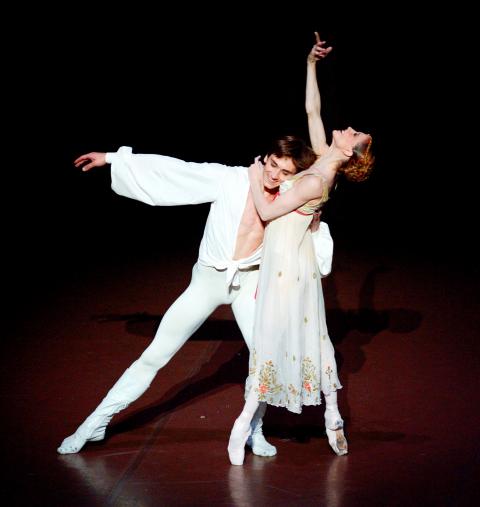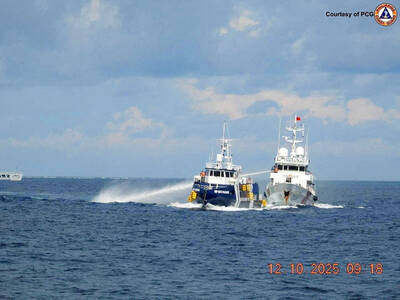The Stuttgart Ballet performed at the National Sun Yat-sen Memorial Hall in Taipei in 1984, and in the audience was a young ballet dancer from Kaohsiung, who was studying in Taipei.
Flash forward 35 years, and Art Wave, the company founded by Wang Tzer-shing (王澤馨) and her husband, Chat Tzongue (謝宗益), are bringing the Stuttgart back to Taiwan for two performances of John Cranko’s renowned interpretation of William Shakespeare’s Romeo and Juliet, at the National Kaohsiung Center for the Arts (Weiwuying) next weekend.
“I was so thrilled and touched,” Wang said about the first time she saw the company, “even now when I think about it, all the great memories come back.”

Photo courtesy of Stuttgart Ballet
Wang and Chat produce the annual International Ballet Stars galas in Taipei, which bring top principals and soloists from the world’s best ballet companies, including the Stuttgart’s Friedemann Vogel and Alicia Amatriain, who both have made frequent appearances.
They have also brought the Universal Ballet (2011 and 2012), the American Ballet Theater (2012), the Staatsballett Berlin (2013) and three Sylvie Guillem shows to the National Theater in Taipei.
So while they know all about the logistics of bringing a major ballet company to Taiwan, arranging two shows in Kaohsiung from their home in Taipei is daunting even with their years of experience.
The Stuttgart is bringing 125 people, including crew; there are 22 Taiwanese to organize for non-dancing roles, rehearsals have to be coordinated for the Kaohsiung City Symphony Orchestra's (高雄市交響樂團) 74 musicians and a master class for local ballet students with Stuttgart members has been arranged, not to mention clearing through customs the three 40-foot containers of sets and costumes for the show that arrived at Port of Kaohsiung at the beginning of the week.
One thing that Wang has learned to cope with in the years of producing galas in Taipei, Taichung and Singapore is that there are almost always last-minute hiccups and casting changes. That has proved true again on Tuesday, but for the best of all reasons.
Stuttgart announced on its Web site that Amatriain and her American partner, soloist Alexander McGowan, are expecting their first baby, and Wang was notified that the Spanish-born ballerina would not be making the trip to Kaohsiung, although McGowan would.
Amatriain and Vogel had been scheduled dance the lead roles on Saturday next week, but now he is to partner the company’s other Spanish principal, Elisa Badenes.
On Sunday, Romeo will be danced by David Moore and Juliet by Anna Osadcenko.
South Africa-born Cranko, who was both choregrapher and artistic director for the company for 12 years, put the troupe on world map with his elaborate story ballets, including another of Shakespeare’s works, The Taming of the Shrew, along with Oneign, Carmen, Poeme de l’Extase and Traces.
He created Romeo and Juliet, set to Serge Prokofiev’s wonderful score, in 1962 for Brazilian ballerina Marcia Haydee, who had joined the company the previous year and soon became his muse, and Ray Barra.
While Cranko choreographed several memorable variations and duets for his two leads, the ballet is packed with star turns — and swordfights — for those dancing the roles of Mercutio and Tybalt, as well as beautiful ensemble scenes that really demonstrate the depth of the company.
Like Cranko’s choreography, the lush costumes and sets by Jurgen Rose have stood the test of time.
Romeo and Juliet is two hours and 40 minutes, including two 20-minute intermissions, so Saturday’s show has an earlier-than-usual start time of 7pm to allow those coming from other parts of Taiwan to make the last Taiwan High Speed Rail trains headed north after the show — and there are many, as the Stuttgart’s production is one not to be missed.
This story has been updated since it was first published to correct the characters for the name of the orchestra.

Many people noticed the flood of pro-China propaganda across a number of venues in recent weeks that looks like a coordinated assault on US Taiwan policy. It does look like an effort intended to influence the US before the meeting between US President Donald Trump and Chinese dictator Xi Jinping (習近平) over the weekend. Jennifer Kavanagh’s piece in the New York Times in September appears to be the opening strike of the current campaign. She followed up last week in the Lowy Interpreter, blaming the US for causing the PRC to escalate in the Philippines and Taiwan, saying that as

This year’s Miss Universe in Thailand has been marred by ugly drama, with allegations of an insult to a beauty queen’s intellect, a walkout by pageant contestants and a tearful tantrum by the host. More than 120 women from across the world have gathered in Thailand, vying to be crowned Miss Universe in a contest considered one of the “big four” of global beauty pageants. But the runup has been dominated by the off-stage antics of the coiffed contestants and their Thai hosts, escalating into a feminist firestorm drawing the attention of Mexico’s president. On Tuesday, Mexican delegate Fatima Bosch staged a

Taiwan can often feel woefully behind on global trends, from fashion to food, and influences can sometimes feel like the last on the metaphorical bandwagon. In the West, suddenly every burger is being smashed and honey has become “hot” and we’re all drinking orange wine. But it took a good while for a smash burger in Taipei to come across my radar. For the uninitiated, a smash burger is, well, a normal burger patty but smashed flat. Originally, I didn’t understand. Surely the best part of a burger is the thick patty with all the juiciness of the beef, the

Would you eat lab-grown chocolate? I requested a sample from California Cultured, a Sacramento-based company. Its chocolate, not yet commercially available, is made with techniques that have previously been used to synthesize other bioactive products like certain plant-derived pharmaceuticals for commercial sale. A few days later, it arrives. The morsel, barely bigger than a coffee bean, is supposed to be the flavor equivalent of a 70 percent to 80 percent dark chocolate. I tear open its sealed packet and a chocolatey aroma escapes — so far, so good. I pop it in my mouth. Slightly waxy and distinctly bitter, it boasts those bright,